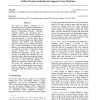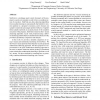12 search results - page 2 / 3 » A comparison of machine learning algorithms for chemical tox... |
ICML
2004
IEEE
14 years 6 months ago
2004
IEEE
The goal of feature induction is to automatically create nonlinear combinations of existing features as additional input features to improve classification accuracy. Typically, no...
IJMMS
2008
13 years 5 months ago
2008
We present automated, real-time models built with machine learning algorithms which use videotapes of subjects' faces in conjunction with physiological measurements to predic...
JMLR
2006
13 years 5 months ago
2006
The Bradley-Terry model for obtaining individual skill from paired comparisons has been popular in many areas. In machine learning, this model is related to multi-class probabilit...
ICML
2007
IEEE
14 years 6 months ago
2007
IEEE
In multi-task learning our goal is to design regression or classification models for each of the tasks and appropriately share information between tasks. A Dirichlet process (DP) ...
ISPASS
2006
IEEE
13 years 11 months ago
2006
IEEE
SimPoint is a technique used to pick what parts of the program’s execution to simulate in order to have a complete picture of execution. SimPoint uses data clustering algorithms...



